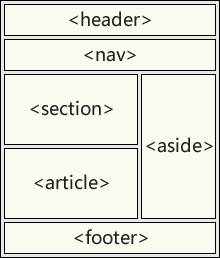今日学习内容:html5语义元素
什么是语义元素?
语义元素清楚地向浏览器和开发者描述其意义。
非语义元素的例子:<div> 和 <span> - 无法提供关于其内容的信息。
语义元素的例子:<form>、<table> 以及 <img> - 清晰地定义其内容。
浏览器支持
所有现代浏览器均支持 HTML5 语义元素。
HTML5 中新的语义元素
许多网站包含了指示导航、页眉以及页脚的 HTML 代码,例如这些:<div id="nav"> <div class="header"> <div id="footer">。
HTML5 提供了定义页面不同部分的新语义元素:
- <article>
- <aside>
- <details>
- <figcaption>
- <figure>
- <footer>
- <header>
- <main>
- <mark>
- <nav>
- <section>
- <summary>
- <time>
HTML5 语义元素

HTML5 <section> 元素
<section> 元素定义文档中的节。
根据 W3C 的 HTML 文献:“节(section)是有主题的内容组,通常具有标题”。
可以将网站首页划分为简介、内容、联系信息等节。
实例
<section> <h1>WWF</h1> <p>The World Wide Fund for Nature (WWF) is....</p> </section>
HTML5 <article> 元素
<article> 元素规定独立的自包含内容。
文档有其自身的意义,并且可以独立于网站其他内容进行阅读。
<article> 元素的应用场景:
- 论坛
- 博客
- 新闻
实例
<article> <h1>What Does WWF Do?</h1> <p>WWF's mission is to stop the degradation of our planet's natural environment, and build a future in which humans live in harmony with nature.</p> </article>
嵌套语义元素
在 HTML5 标准中,<article> 元素定义完整的相关元素自包含块。
<section> 元素被定义为相关元素块。
我们能够使用该定义来决定如何嵌套元素吗?不,我们不能!
在因特网上,您会发现 <section> 元素包含 <article> 元素的 HTML 页面,还有 <article> 元素包含 <sections> 元素的页面。
您还会发现 <section> 元素包含 <section> 元素,同时 <article> 元素包含 <article> 元素。
HTML5 <header> 元素
<header> 元素为文档或节规定页眉。
<header> 元素应该被用作介绍性内容的容器。
一个文档中可以有多个 <header> 元素。
下例为一篇文章定义了页眉:
实例
<article> <header> <h1>What Does WWF Do?</h1> <p>WWF's mission:</p> </header> <p>WWF's mission is to stop the degradation of our planet's natural environment, and build a future in which humans live in harmony with nature.</p> </article>
HTML5 <footer> 元素
<footer> 元素为文档或节规定页脚。
<footer> 元素应该提供有关其包含元素的信息。
页脚通常包含文档的作者、版权信息、使用条款链接、联系信息等等。
您可以在一个文档中使用多个 <footer> 元素。
实例
<footer> <p>Posted by: Hege Refsnes</p> <p>Contact information: <a href="mailto:someone@example.com"> someone@example.com</a>.</p> </footer>
HTML5 <nav> 元素
<nav> 元素定义导航链接集合。
<nav> 元素旨在定义大型的导航链接块。不过,并非文档中所有链接都应该位于 <nav> 元素中!
实例
<nav> <a href="/html/">HTML</a> | <a href="/css/">CSS</a> | <a href="/js/">JavaScript</a> | <a href="/jquery/">jQuery</a> </nav>
HTML5 <aside> 元素
<aside> 元素页面主内容之外的某些内容(比如侧栏)。
aside 内容应该与周围内容相关。
实例
<p>My family and I visited The Epcot center this summer.</p> <aside> <h4>Epcot Center</h4> <p>The Epcot Center is a theme park in Disney World, Florida.</p> </aside>
HTML5 <figure> 和 <figcaption> 元素
在书籍和报纸中,与图片搭配的标题很常见。
标题(caption)的作用是为图片添加可见的解释。
通过 HTML5,图片和标题能够被组合在 <figure> 元素中:
实例
<figure> <img src="pic_mountain.jpg" alt="The Pulpit Rock" width="304" height="228"> <figcaption>Fig1. - The Pulpit Pock, Norway.</figcaption> </figure>
<img> 元素定义图像,<figcaption> 元素定义标题。
为何使用 HTML5 元素?
如果使用 HTML4 的话,开发者会使用他们喜爱的属性名来设置页面元素的样式:
header, top, bottom, footer, menu, navigation, main, container, content, article, sidebar, topnav, ...
如此,浏览器便无法识别正确的网页内容。
而通过 HTML5 元素,比如:<header> <footer> <nav> <section> <article>,此问题迎刃而解。
根据 W3C,语义网:
“允许跨应用程序、企业和团体对数据进行分享和重用。”
HTML5 中的语义元素
下面列出了以字母顺序排列的 HTML5 新语义元素。
| 标签 | 描述 |
|---|---|
| <article> | 定义文章。 |
| <aside> | 定义页面内容以外的内容。 |
| <details> | 定义用户能够查看或隐藏的额外细节。 |
| <figcaption> | 定义 <figure> 元素的标题。 |
| <figure> | 规定自包含内容,比如图示、图表、照片、代码清单等。 |
| <footer> | 定义文档或节的页脚。 |
| <header> | 规定文档或节的页眉。 |
| <main> | 规定文档的主内容。 |
| <mark> | 定义重要的或强调的文本。 |
| <nav> | 定义导航链接。 |
| <section> | 定义文档中的节。 |
| <summary> | 定义 <details> 元素的可见标题。 |
| <time> | 定义日期/时间。 |